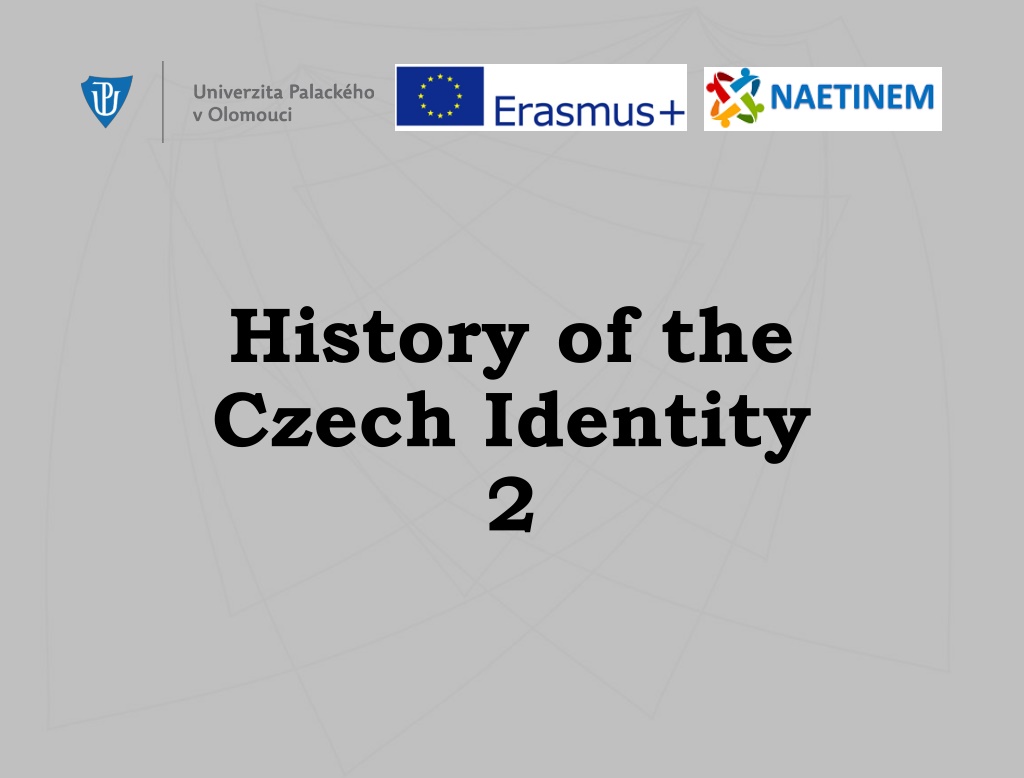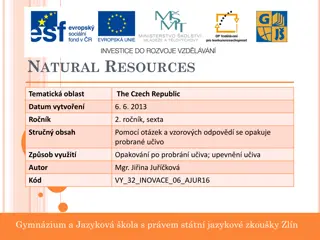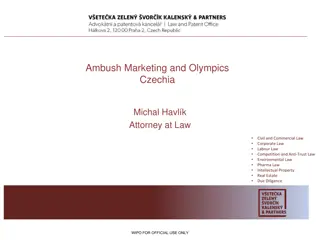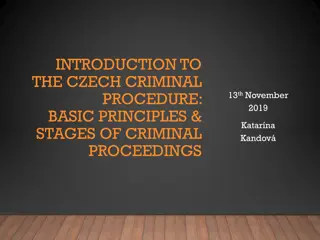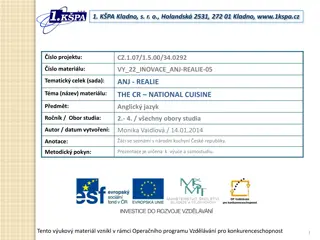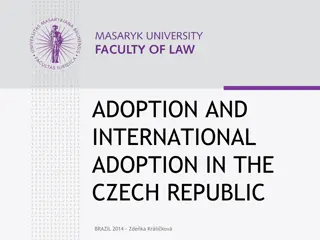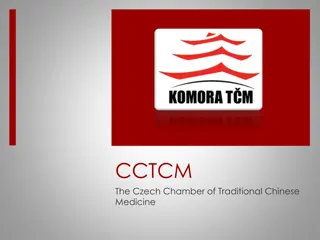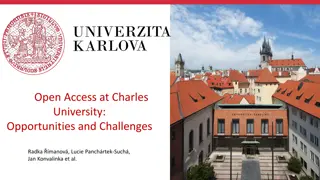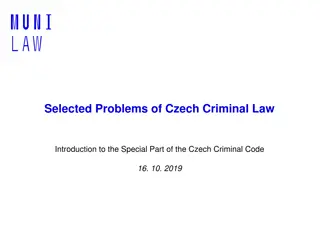The Czech State: Luxembourgs and Charles IV
The history of Czech identity unfolds through the reigns of Luxembourgs, John of Luxembourg and Charles IV. John's territorial expansion and diplomatic efforts marked his rule, while Charles IV faced challenges but consolidated sovereign power in the Czech state. The complex web of alliances, conflicts, and power dynamics shaped the evolving Czech identity during this period.
Download Presentation

Please find below an Image/Link to download the presentation.
The content on the website is provided AS IS for your information and personal use only. It may not be sold, licensed, or shared on other websites without obtaining consent from the author. Download presentation by click this link. If you encounter any issues during the download, it is possible that the publisher has removed the file from their server.
E N D
Presentation Transcript
History of the Czech Identity 2
The Czech State in the Time of the Luxembourgs John of Luxembourg (1310 1346) Rudolf of Habsburg (1306 1307) married Queen Widow Elizabeth Richeza, "King Gruel", dies prematurely in 1307 of dysentery during the siege of Hor ovice Henry of Gorizia (1307 1310), already briefly reigned in 1306, married to Anne of Bohemia; 1309 coup in Prague (patricians), growth of Anne's influence Former Bohemian chancellor and Archbishop of Mainz, Peter of Aspelt negotiations with King of Germany Henry VII of Luxembourg with the support of part of the Czech nobility Accession of John of Luxembourg to the Bohemian throne marriage to Elizabeth of Bohemia Inaugural Diploma 1310, guarantee of rights and liberties for Bohemian nobility, clear starting points for estate power Two segments of the nobility: Henry of Lip , who opposed the king and supported the Ronov family together with the Markvartic family, maintained a relationship with the queen widow Elizabeth Richeza. On the other side were the lords concentrated around Vil m Zaj c of Valdek The internal conflict, in which the Prague Bishop Jan of Dra ice was also involved, ended in 1318 with the Doma lice Treaties further strengthening of the influence of the nobility at the expense of the monarch
The Czech State in the Time of the Luxembourgs John of Luxembourg (1310 1346) Territorial expansion of the Czech state 1322 annexation of the Cheb region, an of Upper Lusatia between 1319 and 1329, Wroclaw in 1335 1335 meeting between John of Luxembourg, Polish king Casimir III the Great and the Hungarian king Charles Robert in Tren n. John of Luxembourg renounced his claims to the Polish crown, and the Polish king withdrew from his ambitions in regards to Silesia. In the 1330s, John of Luxembourg received several Italian cities as pledge (Bergamo, Brescia, Bobbio, Cremona, Milan, Pavia, Novara and Lucca) from the emperor of the HRE At the same time, he conducts an ambitious foreign policy and is practically absent from the Kingdom of Bohemia. King John of Luxembourg fell on 26 August 1346 at the Battle of Cr cy
The Czech State in the Time of the Luxembourgs Charles IV (1346 1378) He was born in 1316 to Elizabeth of Bohemia and was baptised as Wenceslas Later, as a result of marital disputes between John and Elizabeth, he was taken away from his mother and subsequently sent to France for upbringing King Charles IV the Fair, who kept young Wenceslas in his favour, soon confirmed as Charles. He was educated at the French court and met Pierre Roger (future Pope Clement VI). He proved his talent as a ruler in the administration of the city of Lucca and, afterwards, from 1333, in the administration of Moravia as the Moravian Margrave. After returning to the kingdom, he faced adversity from some sections of the nobility, but he did his best to consolidate sovereign power.
The Czech State in the Time of the Luxembourgs Charles IV (1346 1378) Husband to Blanche of Valois; As part of the consolidation of the country, Charles also strived for its further development 1344 elevation of the Prague diocese to an archdiocese (papal bull Romanus Pontifex): Arno t of Pardubice, the foundations of the St Vitus cathedral were laid in the same year; shortly afterwards (30 April 1344) the founding of the diocese in Litomy l In 1346, he took the throne as King Charles and sought to gain the throne of the HRE rival Louis the Bavarian, marriage to Anna of Bavaria (1349) April 7, 1348 foundation of the Prague University, the same year the construction of the Karl tejn Castle began and the foundations of the New Town of Prague were laid
University education Prague university 1348 Universities in the Middle Ages and the Early Modern Period usually consisted of four faculties, which was also the case for the University of Prague: Deans were the heads of faculties. - - - - Faculty of THEOLOGY Faculty of MEDICINE Faculty of LAW Faculty of ARTS The university had the right to award academic degrees: - Bachelor - Master - Doctor
The Czech State in the Time of the Luxembourgs Charles IV (1346 1378) In 1355, completed journey to Rome and received imperial coronation Emperor Charles IV Maiestas Carolina Code strengthening royal power. However, it encountered strong opposition from the nobility and never came into force Marriage to Anna von Schweidnitz in 1353 final incorporation of Upper and Lower Lusatia Golden Bull year 1356, establishing the election of the German King 7 electors After the death of his wife Anna von Schweidnitz (1362), inheritance in the form of Schweidnitz and the Duchy of Jawor Silesia as a whole becomes part of the Czech lands Lands of the Czech Crown Kingdom of Bohemia, Moravia, Silesia, Upper Lusatia, Lower Lusatia, Feuda extra curtem (foreign fiefdom, New Bohemia), Brandenburg 1363, marriage to Elizabeth of Pomerania in Krakow In 1373, Charles IV acquired Brandenburg Shortly before his death, he made a trip to France attempted, among other things, to settle the papal schism Charles IV died 29 November 1378; autobiography Vita Caroli
Lands of the Czech Crown Term for the collection of states, which was adopted during Charles IV's reign - - - - - - Bohemia: Prague (Caput regni) Moravia: Brno and Olomouc Silesia: Wroclaw Upper Lusatia: (Bautzen, G rlitz, Zittau) Lower Lusatia: Chot buz (Cottbus) (Luxembourg, Brandenburg, Feuda extra curtem)
The Czech State in the Time of the Luxembourgs Wenceslas IV (1378 1419) Born in 1361 in Nuremberg to Anna von Schweidnitz; in 1363 he was crowned by Archbishop Arno t of Pardubice as King of Bohemia, in 1376 he was elected King of Germany in Aachen He began ruling in 1378, at a time when the Czech state was gradually falling into an internal crisis exacerbated by the plague epidemic of 1380. He appointed lower nobility (favourites) into the royal offices, which subsequently provoked disputes with the upper nobility and Archbishop Jan of Jen tejn arrest of vicar general Jan of Pomuk (1393) League of Lords in 1394 Wenceslas IV was captured (with the knowledge of the Moravian Margrave Jobst) in Kr l v Dv r and transferred to Wildberg Castle, subsequently freed by his brother John of G rlitz Complications in the HRE in 1400 Wenceslas IV deposed from the German throne (replaced by Ruprecht III of the Palatinate) 1402 1403, Wenceslas IV interned again (Vienna), at the behest of his brother Sigismund among others. After his release, he was forced to accept the demands of the high nobility. Growing social unrest From the 1380s, signs of a reformation movement are beginning to appear in the Czech lands they are generally related to the worsening situation of the country, bands of thieves, internal instability, the absence of law (Jan i ka) Predecessors and Contemporaries of Hus Konrad von Waldhausen, Jan Mil of Krom , Matthias of Janov, Tom t tn of t tn , Jacob of Mies, Master Christian of Prachatice, Jerome of Prague, Master Jan of Ji n. Inspired by the English scholar John Wycliffe
The Czech State in the Time of the Luxembourgs Wenceslas IV (1378 1419) In January 1409, Wenceslas IV puts out the Decree of Kutn Hora regulates the ratio of votes at the Prague university in favour of the Czech university nation. Hus's reformist group gains control of the university. In 1410, Wenceslas's brother Sigismund of Luxembourg is elected as King of Germany. Increasing tension between Wenceslas IV, who (together with his wife Sophia of Bavaria) sympathises with the reformists, and Archbishop Zbyn k Zaj c of Hazmburk; Bethlehem Chapel as the main pulpit of the reformists John Hus (ca. 1370 1415) comes the forefront of the reform movement critique of the sale of indulgences and the deviation of the Church from fundamental principles the demand for its rectification, respect for God's law, following Christ's example and principles. The highest authority for a believing Christian is the Holy Scriptures the New Testament and the word of God contained within. Belief in the salvation of true believers. Followers of John Hus come to be called HUSSITES. Tensions between the reformists and the king soon escalated. An interdict is made against Hus leaves Prague. 1414 general ecclesiastical council convened in Constance, John Hus is also invited unsuccessful attempt to defend his reform ideas, which eventually led to his condemnation as a heretic burnt at the stake on 6 July 1415 (Jerome of Prague then burnt in May 1416) Hus's burning caused considerable uproar in Bohemia a letter of complaint from the Czech nobility, social tensions escalated and the dividing line between Hussite followers and Catholics further widens. 30 July 1419 First Defenestration of Prague, Jan elivsk , shortly after 16 August 1419 Wenceslas IV dies
The Hussite Revolution (14191436) Following the death of Wenceslas IV, Sigismund of Luxembourg becomes the heir to the Czech throne At the same time, the internal situation within the kingdom and especially in Prague worsened The Hussites begin to separate into two factions radicals and moderates Establishment of T bor millennialist visions, radicalism (called Taborites) Sigismund tries to enforce his claims to the throne the situation eventually results in a crusade and the Battle of V tkov in July 1420. Jan i ka of Trocnov as a leading Hussite military commander and strategist. Following his failure, Sigismund withdraws 1421 (June), slav Assebly approval of the Four Articles of Prague as the central law of the land (1.Free proclamation of the Word of God; 2. Communion under both kinds; 3. Prohibition of secular rule of priests; 4. Punishment of "deadly" sins). Twenty-member council of the Kingdom of Bohemia provisional government of the land (upper and lower nobility with representatives of cities) Communion under both kinds sub utraque specie Utraquists, Chalicers Finding a suitable candidate for the vacant royal throne Sigismund Korybut The Hussites, led by Jan i ka, repel another invasion by Sigismund Battle of N meck Brod in January 1422
The Hussite Revolution (14191436) Gradually, four main Hussite unions are formed (strengthening the role of cities) Prague Municipal Union T bor Municipal Union East Bohemian (Sirot /Orphan) Municipal Union Union of Jakoubek of V esovice In 1423, Jan i ka put together a new Hussite union in Eastern Bohemia i ka's Military Law. Disputes with moderate Hussites (Prague after the execution of Jan elivsk ) and the Catholic nobility. Role of en k of Wartenberg. June 1424 Battle of Male ov Jan i ka died on 11 October 1424 during the siege of P ibyslav, legacy continued by Jan Roh of Dub
The Hussite Revolution (14191436) New Hussite military commander Prokop Hol Disagreements and tensions between the individual Hussite factions continued (the coup in the Old Town of Prague in 1427 and the removal of radical Hussite council members) Battle of st nad Labem (1426), Battle of Tachov , Battle of Doma lice Hussite glorious rides raids Efforts to find compromise 1432 iudex Egrensis (Judge of Cheb). Subsequent negotiations with the Hussites at Council of Basel
The Hussite Revolution (14191436) Reignited disputes between radical and moderate Hussites Taborites and Orphans versus the Prague Union (Jan Rokycana), moderate Hussites and the Catholic nobility 30 May 1434 Battle of Lipany Taborite-Orphan group led by Prokop the Bald defeated This opens the way to a compromise Compacts of Basel (promulgated in Jihlava) in 1436 adopted an article permitting communion from the chalice, as well as other articles in a truncated form First country in Europe where communion under both kinds was officially recognised. Sigismund of Luxembourg ascended the Bohemian royal throne but died in 1437 Archbishop of Prague Jan Rokycana Upper Consistory (Catholics), Lower Consistory (Chalicers) Strengthening the influence of cities on the administration of the country especially in Bohemia Albert of Habsburg (1437 1439) Ladislaus the Posthumous 1440, election of the "administrative" committee 18 lords, 14 members of the lower nobility and 14 burghers
Reign of George of Podebrady (14581471) Landfrieden regional military-political groups ensuring order and legal conduct East Bohemian Landfried led by the noble George of Kun t t and Pod brady, a supporter of the chalice and the Compacts In 1448, he took control of Prague From 1452, George of Pod brady was the provincial steward, in 1453 King Ladislaus began reign, but then died in November 1457. On 2 March 1458, George of Pod brady was elected King of Bohemia the first elected King of Bohemia
Reign of George of Podebrady (14581471) George of Pod brady ensured the observance of the Compacts, opposed the newly established Unity of the Brethren However, much of Europe perceives the Czech state and Utraquists as heretics (see Francois Villon and his poems). Pope Pius II also speaks openly against Pod brady. The Czech king counters these tendencies through a diplomatic offensive project for a union of European monarchs delegation led by Leo of Ro mit l (1464) Internal resistance of the Catholic nobility Green Mountain Union, 1467, suppressed Pope Paul II imposed an interdict on George of Pod brady in 1466, in 1467 the Hungarian king Matthias Corvinus spoke out against him (crusade against the "Czech heretics") Both sides of the conflict experienced victories and losses (capture of Matthias Corvinus near Vil mov), in 1469 Corvinus was crowned King of Bohemia in Olomouc by the Catholic estates. However, George of Pod brady effectively remained in power in Bohemia prior to his death (March 1471) he concluded an agreement with King Casimir IV of Poland about the succession of the Jagiellonians
Jagiellonians on the Czech Throne Vladislaus Jagiellon (1471 1516) After the death of George of Pod brady, the Polish prince Vladislaus Jagiellon was elected on the basis of agreement among segments of the nobility. However, in practice he again rules only in the Kingdom of Bohemia (Moravia, Silesia and both Lusatia remained under the control of Matthias Corvinus) Peace of Olomouc 1479: agreement with Matthias Corvinus on succession, Corvinus retained his reign in the neighbouring countries Effort from Catholics to gain control of the kingdom resulted in an anti-Catholic uprising in Prague in 1483 and the Second Defenestration of Prague. Vladislaus Jagiellon forced to accept the demands of Utraquists. This was affirmed at the Kutn Hora Assembly in 1485 Catholics recognised the Compacts as a fundamental law of the land the so-called Religious Peace of Kutn Hora. Strengthening the estates' position in the state this continuous process since the end of the Hussite wars culminates during the reign of Vladislaus Jagiellon.
Jagiellonians on the Czech Throne Louis Jagiellon (1516 1526) After the death of Matthias Corvinus in 1490, Vladislaus Jagiellon received the Hungarian royal crown and moved to Buda. He did not spend much time in the Czech lands, which only further strengthened the power of the estates After the death of Vladislaus Jagiellon, his son Louis Jagiellon was elected to the Bohemian royal throne and he, like his father, stayed mainly in Hungary. 1517 the so-called St Wenceslas Agreement: acknowledgement of certain privileges for cities while also allowing the nobility to conduct business (limiting the economic profits of cities) Early 16th century marked by the Turkish threat in the Balkans. The Ottoman Empire expands further north-west and threatens the Kingdom of Hungary King Louis tried to confront the threat assembled an army of of the estates from Hungary and the Bohemian lands, and the decisive Battle of Moh cs takes place on 29 August 1526 The troops of Louis Jagiellon succumbed to the overwhelming superiority of the Ottomans under the command of Sultan S leyman I and King Louis himself perished while retreating from the battlefield
Estates Monarchy and Its Administration - The estates monarchy quickly develops after the Hussite Wars (see previous slide) and this process is further accelerated by the religious peace of Kutn Hora. - 1500 Vladislaus Land Order strengthened estate institutions (diet) while side-lining cities, which gained important positions in the estate administration after the Hussite period. Diets - Bohemian Diet Prague (colleges of upper nobility, lower nobility and representatives of the cities) headed by the supreme burgrave Moravian Diet Brno (Olomouc), retention of clergy positions headed by a governor Silesian Diet Wroclaw; in Silesia there were also local (princely) assemblies in individual principalities headed by a supreme governor Upper Lusatian Diet headed by the Upper Lusatian advocatus Lower Lusatian Diet headed by the Lower Lusatian advocatus - - - - - General Assembly of the Lands of the Bohemian Crown representatives of all crown provinces - Important role of individual provincial courts. Resolutions of assemblies recorded in the so-called land tablets (they differed based on the agenda market, citational )
Estates Monarchy and Its Administration - In addition to the provincial diets i.e., estate administration there was also the administration of the monarch (king) represented since the last P emyslids by the court authorities - With the arrival of the Habsburgs in 1526 (Ferdinand I) comes an effort to centralise the royal (state) administration in Vienna as much as possible. Central Offices - Court Chamber (Hofkammer) superior financial administration office - Secret Council (Geheimer Rath) foreign and domestic policy, the most important central body - Court Chancellery (Hofkanzlei) conceived as the supreme superior body of court chancelleries in individual crown provinces - Court War Council (Hofkriegsrath) defence of states, upkeep of troops and other aspects related to the military
